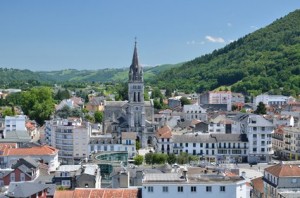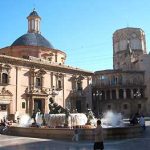 The Lowdown on Tacky Souvenirs and Christian Kitsch – Hautes-Pyrenees France
The Lowdown on Tacky Souvenirs and Christian Kitsch – Hautes-Pyrenees France
I think it was Goethe who said that the imagination was man’s “deadliest enemy,” but how could that be so when all of us have dreamed up so many fabulous places to visit, celebrity people to admire, and unique pleasures to seek out.
Even so, nightmares notwithstanding, we are all vaguely astonished when legend becomes reality and we actually arrive in a place we have only heard about when we secretly believed it didn’t really exist. What good is Euro Disney when you have never actually been there? Do we take our prejudices and biases with us when we depart planet earth?
Lately there has been much speculation that there might have been a massive flight from heaven on account of expensive real estate foreclosures. So spiritual seekers must make do with the pilgrimage sights they already have on earth: The Vatican, Jerusalem, Santiago de Compostela. . . .
Indeed, William Shakespeare struck spiritual paydirt with the classic line, updated from archaic Elizabethan English more or less: “There are more things under heaven and on earth than are dreamed of in your philosophy.”
At the time of my “pilgrimage,” I was a housesitter for an old English couple in historical Gascony, overseeing a 15th-century farmhouse with a backyard view of the snow-capped Pyrenees, so I was suffering from a little cabin fever anyway. I needed only a light excuse to drive far and wide in search of an adventure, if not of the heart then of the soul.
I had never really heard of Lourdes, in France, for example, except as a place name in a memorable Monty Python sketch, until I saw a French friend’s plastic shake-up Jesus toy, which she had acquired from this Pontiff-approved holy city with a domestic nod to the Popes of Avignan.
Immediately, I jumped out of my skin like a stark naked ghost in order to try to get one for myself. My French friend was of course in the kitchen, peeling potatoes as if conducting a series of grim biopsies. I didn’t dig “moules frites” anyway, so I convinced my recalcitrant friend to take a break—and maybe, peradventure, the charmed Savior tchochka was for sale?
“Non, absolument!” was her opening salvo. Her peeved reaction was caused by a mind buzzing with ancient superstitions and worldweary prayers. Also I could tell she thought I was making fun of her.
So summoning the rest of my brio, I decided we would have to put foot to pedal and actually go to Lourdes. I was a little religious after all: I bought a Christmas tree every year even though I was pretty much a no-show on Sundays at any available Churches. However I had seen more famous Cathedrals than most people, as a tourist admiring the architecture rather than a skeptic harboring hokum. I had been to famous churches throughout Europe, each known in commercial bus-tour slang as an AFC (Another [Frigging] Church).
The somewhat vanilla subject matter of most of our holiday-inflected media, from People Magazine to “Oprah,” were deemed bromides for our moderniste manias for secular popular culture—when, in reality, only highbrow speculation matters, matters of the spirit rather than the mind. Few philosophies survive without followers, and Christianity was a keeper, one which has already haunted us for 2012 years. Obviously, with the world still here, millennial angst abating, The Final Battle between Good and Evil ended up a tie.
Again, I decided I would get rid of my spiritual sloth by visiting a scenario where seemingly genuine miracles have been recorded, including cases of cripples who learned how to walk again with proprioception and panache: “It all begins with the left foot,” I imagined a voice saying. For sure, I would get down on my knees if some incredible miracle came true: such as forgetting laser eye surgery in favor of awakening second sight.
In the nearby departement of “Hautes-Pyrenees,” upon-high Lourdes (420 meters/1,380 feet), a pleasant market town sliced by the river Gare de Pau and featuring a rock outcropping called “Massabielle” (Old Mas), is justly famous for the “Marian Apparition of Our Lady of Lourdes” (1858), which sounded like the perfect drive-through for a long lunch, worthy of an undercover reviewer from Michelin disguised as a truck driver.
Word spread quickly, and ever and anon, first thousands, and then millions, paid their respects to the paranormal vision of a 14-year-old waif who witnessed a supernatural haunting of sorts in a conveniently located cave overlooked by a castle in the escarpment.
Lourdes (with 15,000 souls) swells with over five million pilgrims per annum. With almost 300 hotels, Lourdes is also the second largest collection of tourist housing in France, after only Paris.
All people coming to Lourdes for the first time are automatically interested where a small girl named Bernadette Soubirous witnessed miraculous sightings of what the apparition called “The Immaculate Conception” (The Virgin Mary) over 18 times in The Grotto Mervaillaise. This cozy cave was where bubbled mineral waters with natural healing properties, even better than Evian. In fact, since the late 1800s, the spring has gushed 27,000 gallons a week for the faithful to swallow.
After checking out the “sights,” including the clunky-sounding must-see of “The House of Bernadette Soubirons’ Parents” and the Gothic fortified-chateau “The Lourdes Castle and Pyrennean Museum,” I edged toward the Basilica of the Rosary, one of the largest Romanesque cathedrals in the world.
And yet, why was I more impressed with a sight about ten minutes away by walking shoes? There above me rose five domes boldly declaiming in the opaline semen-colored sky, what exactly? Abstinence? This was St. Mary’s Ukrainian Catholic Church (8 Rue de l’Ukraine), designed by the genius architect Miroslav Nimciv, and whose breathtaking interior of polychrome decorations were executed by hotshot artist Jerzy Nowosielski, leaving only one word behind in my psyche: “Uh”?
Well, that’s what I liked about it, its stark originality rather than its staying power.
But when I found out that over 200 million people had visited Lourdes since 1860—much less than McDonald’s claim of “6 Billion Served” (Le Big Mac, si’il vous plait)—I realized this was more than enough for one sanctuary, not a franchise, to be extremely noticed.
It seemed like I had entered the colorized terrain of “Lourdes,” by Emile Zola (1840-1902). Instead of backing off from the unknown, I suddenly felt very religious in wanting to know the truth behind the reality. While watching the moribund arrive in their wheelchairs and crutches, icon eyes ablaze with spiritus sanctu, waiting in line to drink from the magical springs and manage a private miracle, I balked.
An old hag in dark widow clothing with a strained reptilian smile crawled on her knees in front of my like a black adder.
In the tchochka-filled streets of Lourdes, in all the museum-quality tourist shops offering souvenirs, I didn’t know whether I should go for the sacred or profane, the holy or the hollow. Granted, I was indeed tempted by the Velvet Savior black light poster or hot pink gumball-shaped rosary beads. Surprisingly, I was happily contented enough—why, I’m not sure–in just getting a minor miracle haggled down to a proverbial steal (Christian kitsch for the dirty rich).
That’s right, just another plastic Jesus shake-up toy. . . .
No wait, I’ll take the crucified Santa!





Leave a Reply